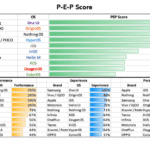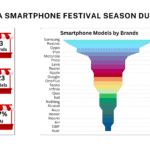The 1H of 2023 (Jan-Jun) has been in line with expectations. However, it was not expected that the sales for smartphones would go under 50 million for the period. We estimate the smartphone sales for the period at 49 million, which is roughly 25% lower than the usual run rate. However, in terms of revenue, we are expecting this year to close at $42 billion, up by around 18% over previous year.
Trends
Some of the market trends that are worth capturing from Jan 2023, which have a strong bearing on the overall market of smartphones for 2023 are: –
- The 5G continued to be the key proposition. Gradually we saw it becoming available in the lower mid-premium segments paving way for affordable 5G smartphones.
- The ‘R-brands’ of Redmi and Realme are finding it difficult to transform with the market changes. There is a strong resistance from consumers to explore their products beyond ₹20,000 segment.
- Samsung has gone aggressive with its M series attack on the affordable segment. While it continues to leverage is strong hold on the ultra-premium android segment, M series has established it in the lower crust.
- Nord has emerged among a very successful series that smartphones have had so far. This has strengthened OnePlus’ beyond the premium segment.
- Apple drove the luxe (>₹50,000) growth with Samsung as the de facto choice of consumers wanting to buy Android beyond ₹100,000.
- It’s the return of offline for brands as they started focusing across the mediums. Amazon has gained edge over Flipkart and other marketplaces in terms of selling smartphones.
- Lava has made a comeback ending the debate that there is no room for Indian brands.
- Motorola, and Tecno from Transsion Holdings have shown good results with a balanced presence in offline and online channels.
- From the macro-economic point of view, Fitch Ratings has revised its GDP growth for India to 6.3% against the previous estimate of 6% for the financial year 2023-24. This indicates a better economic scenario with a positive outlook expected for the year.
- The consumer inflation has also been lower than the previous year. Though in June 2023, the provisional CPI (General) released by the Ministry of Statistics and Programme Implementation (MoSPI) was at 4.81% compared to 4.31% for May 2023, it is 2.2 percentage points less than inflation of June 2022.
Predictions
Keeping in view the above events and movements, we forecast the following for the remaining 2nd Half (Jul-Dec) of 2023.
- 5Gisation in the affordable segment will drive the smartphone sales. More than 58% of the total smartphones sold in 2023 are expected to be 5G. While there will be attempts to have ‘symbolic’ sub ₹10,000 5G smartphones, we believe the market to have a range of 5G smartphones starting ₹12,000 helping in mass adoption of 5G smartphones in 2023 and beyond.
- We are optimistic about 2H sales and feel that the market will be able to make up the weak response of 1H with the total sales registering around 140 million mark by the end of 2023. Affordable 5G smartphones and replacement cycle will drive this growth.
- Battery capacity and fast charging capability in new models will also contribute towards pushing the replacement of smartphones purchased prior to 2020. With content consumption especially in video format due to consumption of short format reels, etc., the battery requirements are going up triggering an upgrade.
- The availability of 5G chipsets in the mid-range is allowing OEMs to consider making more 5G smartphones with affordability at the centre stage. While Samsung is leveraging its own Exynos, other OEMs are likely to leverage from mid-range portfolio of Qualcomm and MediaTek. Historically we have witnessed MediaTek playing a key enabler’s role in mass adoption of technologies like 3G and 4G, which we expect to continue in 5G also.
- The offline channel is expected to contribute 53% of the sales while online will contribute the remaining 47%. Brands across segments and their origin have strengthened their offline presence by not only expanding but also committing in terms of making available the fast-selling models and the adequate inventories to their offline partners as well. In the online, we expect Amazon to have an edge over Flipkart, while in the offline, brands may start relying on partners like Redington for quick offline effective expansion.
- The expected market rankings for 2023 with the present realignments are Samsung, Vivo and OPPO in that order. Beyond these 3 ranks it is expected to remain volatile among brands including Redmi, Realme, OnePlus, Tecno and Motorola. (The rankings here are based on individual brands and does not count any sub / daughter brands).
- The 2H market situation will be determined by the sales of crucial months of August-October.
Conclusion
The value chain challenges that got a push after covid-19 pandemic are increasingly working in favour of the smartphone brands having a greater control / access to the supply chain. Going forward Techarc expects smartphone OEMs having deeper emphasis on R&D, own manufacturing or strategic manufacturing partnership and a direct access to the consumer across online and offline channels to be in leadership positions.
The macro-economic indicators are favourable than previous year which is expected to drive positive consumer sentiment in the 2nd half of the year reciprocating the festive season preparations of the smartphone brands.
Looking at the market dynamics it might be a winning strategy for the brands to remain focused on their key market segments and avoid playing in all the segments, especially where they find resistance from consumers in adoption. Barring a few smartphone brands that includes Samsung, Vivo and OPPO which have distributed presence in a few segments, it will be in the interests of respective brands to confine their activities in their core segments aggressively. While consumers are buying premium smartphones, it doesn’t mean that there is no scope in the affordable segment for 5G. Rather than all brands attempting to go after the premium opportunity and get limited success, it is recommended that every brand tries to work on the 5G opportunity within the stronghold segment.
The 140 million smartphone sales is an uphill task but still achievable looking at the big picture that includes the 5G opportunity in the affordability segments, macro-economic conditions and the replacement cycle potential sales. The execution of the key brands in terms of limiting their competition by narrowing operations will be a key enabler in this scale.






One response to “Techarc mid-year review – India Smartphone Market”
[…] in India for budget-conscious buyers. Despite its low price, the new entry-level G-series handset includes certain high-end features typically associated with mid-range counterparts priced nearly […]